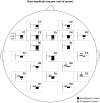"Too Many betas do not Spoil the Broth": The Role of Beta Brain Oscillations in Language Processing
- PMID: 22737138
- PMCID: PMC3382410
- DOI: 10.3389/fpsyg.2012.00201
"Too Many betas do not Spoil the Broth": The Role of Beta Brain Oscillations in Language Processing
Abstract
Over the past 20 years, brain oscillations have proven to be a gateway to the understanding of cognitive processes. It has been shown that different neurocognitive aspects of language processing are associated with brain oscillations at various frequencies. Frequencies in the beta range (13-30 Hz) turned out to be particularly important with respect to cognitive and linguistic manipulations during language processing. Beta activity has been involved in higher-order linguistic functions such as the discrimination of word categories and the retrieval of action semantics as well as semantic memory, and syntactic binding processes, which support meaning construction during sentence processing. From a neurophysiological point of view, the important role of the beta frequencies for such a complex cognitive task as language processing seems reasonable. Experimental evidence suggests that frequencies in the beta range are ideal for maintaining and preserving the activity of neuronal assemblies over time. In particular, recent computational and experimental evidence suggest that beta frequencies are important for linking past and present input and the detection of novelty of stimuli, which are essential processes for language perception as well as production. In addition, the beta frequency's role in the formation of cell assemblies underlying short-term memory seems indispensable for language analysis. Probably the most important point is the well-known relation of beta oscillations with motor processes. It can be speculated that beta activities reflect the close relationship between language comprehension and motor functions, which is one of the core claims of current theories on embodied cognition. In this article, the importance of beta oscillations for language processing is reviewed based both on findings in psychophysiological and neurophysiological literature.
Keywords: beta; brain oscillations; coherence; frequency; language; power.
Figures





References
-
- Amzica F., Lopes da Silva F. H. (2011). “Cellular substrates of brain rhythms,” in Niedermeyer’s Electroencephalography: Basic Principles, Clinical Applications, and Related Fields, eds Schomer D. L., Lopes da Silva F. H. (Philadelphia: Lippincott Williams & Wilkins; ), 33–63
-
- Babiloni C., Babiloni F., Carducci F., Cincotti F., Cocozza G., Del Percio C., Moretti D. V., Rossini P. M. (2002). Human cortical electroencephalography (EEG) rhythms during the observation of simple aimless movements: a high-resolution EEG study. Neuroimage 17, 559–57210.1006/nimg.2002.1192 - DOI - PubMed
LinkOut - more resources
Full Text Sources
Other Literature Sources
Miscellaneous

